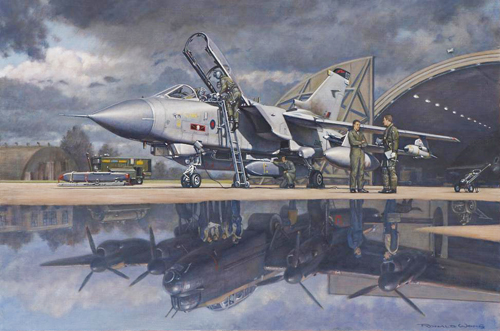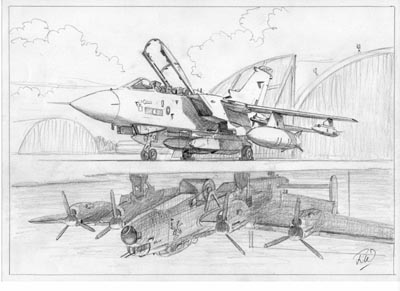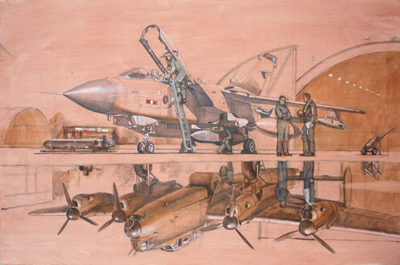
“Reflecting on 70 Years”
No.617 Squadron approached me during late 2012 to commission a painting to celebrate their 70th anniversary in March 2013, a milestone event in the history of that famed squadron. This is the second commission I have painted for 617, the first on the occasion of their 60th birthday*. And once again I felt the urge to sidestep painting yet another permutation of that famous night-time scenario over the Mohne Dam. Having got away from it once, what to do now for the encore? How to make things “different” with this one?
Light reflections have always fascinated me, and I have used them to advantage in my paintings whenever the opportunities presented themselves. Everything reflects its surroundings, for otherwise they would not be visible to us, and it serves artists to be aware of this wondrous crystalline world we inhabit, where the intricate effects of light transcend and unite the diversity of objects within it. Wet surfaces and puddles can be especially effective for relieving the monotony of boring foregrounds like airbase tarmacs. The recent British winter has provided chances aplenty to observe the mirroring action of collections of excess rainwater, appearing to present portals into magical nether worlds. This struck me as possibly a solution for this important painting, using reflection to bridge past and present and sum up the Dambuster heritage in a single visual swoop. I hastily assembled a preliminary sketch of the idea (Fig.1), and luckily for me, 617 immediately took to it.

Fig.1: Concept Sketch
The squadron required a fairly large canvas of 24 x 36 inches, which would yield a framed size some 6 inches more in each dimension. Transferring the layout to the canvas was straight forward, and as usual, I began by outlining the subject in pencil, followed by an overall acrylic wash of a warm and fairly neutral tone( Fig.2). The oil paints then went on, first defining the areas of light and shadow in the composition before moving in with additional colour.

Fig.2: On to the Canvas
The image is designed to be rich in intellectual correspondences and polarisations; the Storm Shadow stand-off missile above vs. Upkeep below, the rounded Lossiemouth aircraft shelters vs. the old square Scampton hangars, the current airfield equipment vs their WWII counterparts, and so forth. There is a discrepancy in size between the two aircraft in real life, the Lancaster being substantially larger, so a certain amount of licence had to be applied to the dimensions of the reflected image. To help matters visually, I set the Lancaster a little further back in the scene than the Tornado above. The nose-up, rear-wheeled Lancaster image is complemented by taking a very low-level(and therefore also nose-high) perspective of the Tornado. Every step of the way, I was ably assisted by the Lossiemouth aircrew and engineers in matters of technical detail and by the 617 squadron historian on points of historical. accuracy The close-up views of both aircraft in the big canvas afforded no fudging of detail, and the nit-picking was fast and furious as the emails, often with attached digital snapshots, flew back and forth across the internet.
For the background I chose a dark, turbulent sky to a) bring out the light-coloured, Tornado and b) energise the image in compensation for the sharply-defined and static foreground. The sunlit Tornado was in continual dynamic competition with that dark doppelganger below, but I was not overly concerned. Reflections on water are always partial, a significant part of the incident light being absorbed, with the result that reflected images are always more subdued than the object reflected. So once everything was in place, and the paint reasonably dry, I could just knock back that aggressive Lancaster reflection with one or more broad-brush glazes. The black dog, by the way, was an afterthought.
On the face of it, this radical compositional juxtaposition may seem a step beyond the usual bounds of the strictly “representaional”. Some may describe it as surrealist. But then it could be argued that the perspectives of many of the aerial scenes we routinely paint imply implausible or impossible observational points, and are therefore paradoxical(and surrealist?) images in terms of perspective rules. For all their apparent realism the arbitrary perspective structures expose them as synthetic, virtual imagery, expressions of artists’ minds rather than anything capable of being actually witnessed. Perhaps the painted images which really qualify as representational are those static, feet-on-the-museum floor portraitures where the perspective relationship between observer and object remains intact.**
The finished and framed anniversary painting, shown at the top of this article, was safely conveyed by UPS to Lossiemouth, where it formed the centrepiece for the Dambusters’ 70th Anniversary Dinner party on March 23, 2013. The painting was accompanied by 617 copies of signed prints to be used to raise funds for the Leonard Cheshire Disability Charity***.
As much as I enjoy the continual flow of commissions from air force units, in recent years there has often been a sad note to some of them, as increasingly they have been for farewell paintings(and prints) as squadrons and airbases faced imminent closure. A further, ominous note is that I have on my books the first commission for a pilotless drone!
Ronald Wong GAvA
April 2013
* See http://www.ronaldtkwong.com/gallery/ProvidingCover.....html
** It may be well here to paraphrase Rene Magritte: “Ce ne sont pas des avions”.
*** Print copies in support of the charity are available at www.dambusters70.com